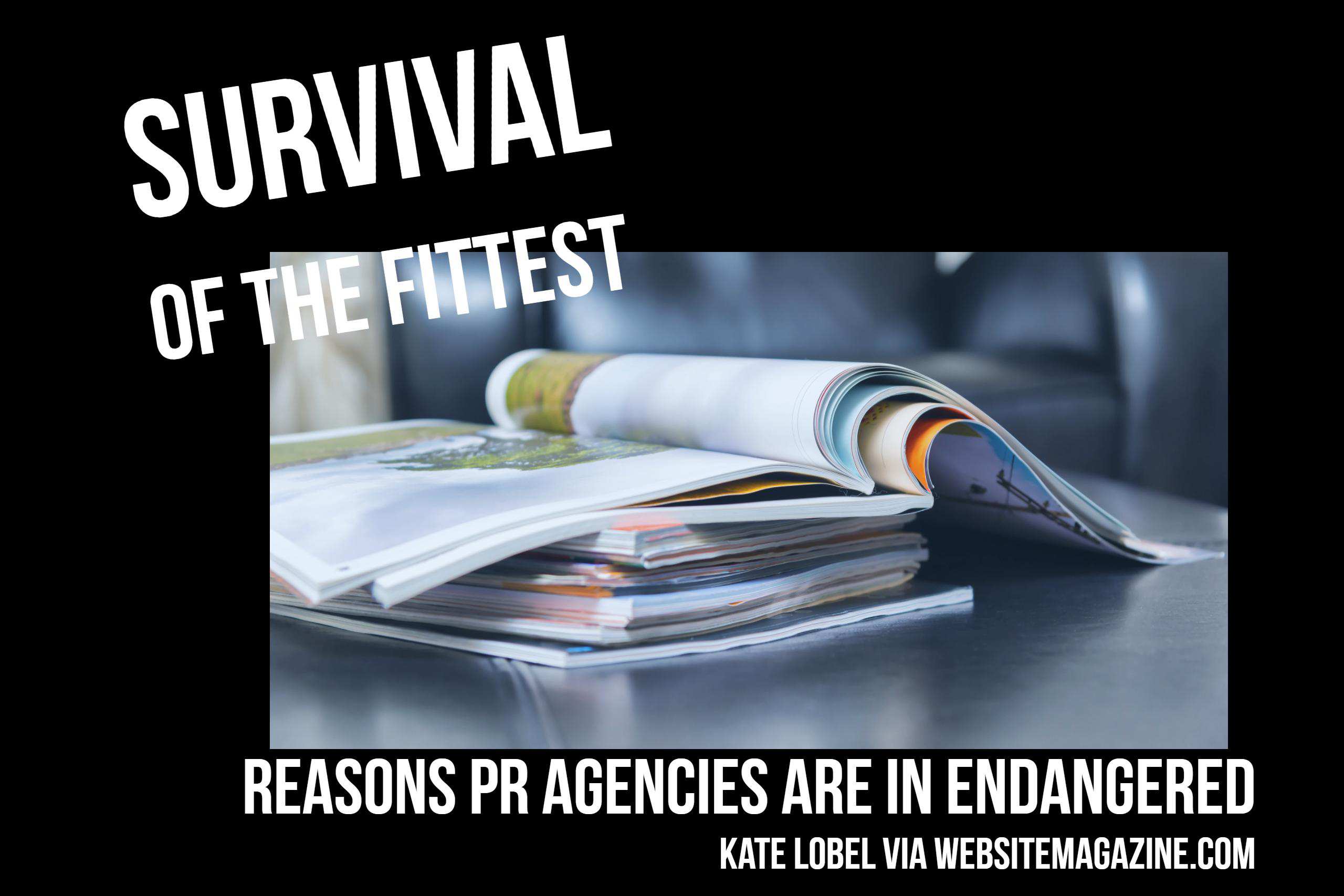Survival of the Fittest: Reasons Public Relations Agencies are in Endangered

by Kate Lobel
29 Aug, 2017
Understanding the public relations industry's digital evolution is no longer an option, but rather a necessity for PR and marketing agencies to stay relevant to the growing and interconnected digital space. The expansion of technology within industries has changed the way people consume and interact with media. Knowing this, traditional PR tactics and reporting techniques now fail to communicate the critical details clients expect when looking to assess the success of their marketing and PR campaigns, and ultimately their bottom line.
Forward-thinking agencies that view PR with a digital lens, see traditional media relations as a necessary component of a PR campaign, however, they also understand the need to incorporate digital elements into their work to ensure PR efforts deliver maximum results and seamlessly support cross-channel marketing initiatives and goals.
You might be wondering, "where does PR fit into a comprehensive digital marketing strategy?"

Go Beyond Traditional PR Measurements
Typically, public relations reports focus on aspects such as monthly visits, traffic and overall impressions. However, these high-level metrics are no longer sufficient for clients looking to understand the details of their actual return on investment (ROI). Clients want to be able to see what their money is getting them and not just assume that out of the total impressions there were some conversions.
Google Analytics allows you to go in depth with data to understand the direct amount of traffic coming into the website, the behavior of those people and their demographics. In addition, you can identify with a hard number the amount of traffic the link in your placement drove back to your website. To take it one step further, you can also identify how long particular customers stayed on your site coming from your placement. Most importantly you can also identify if they actually converted or not.
PR is also considered a top of the funnel, first impression channel that usually doesn't lead directly to conversions. PR is a brand introducing channel affecting the direct channel drastically and also affecting other channels. You might be wondering, "How can I tell if PR affected other digital channels?" Well, the first place to look would be in GA under goals and finding the assisted conversions. From there, you will be able to pick out individual placements to then identify the entire customer journey from introduction to conversion. More to come on this!
Team Up with SEO
Considering how intensely noisy the Internet landscape has become PR and SEO are now needing to work together like never before in order to adapt to the newly integrated and competitive digital space the industry has evolved into.
Working with SEO allows PR professionals to ensure the coverage they intend to secure actually adheres to Google's policies. Using tools like Moz's Open Site Explorer and Majestic to name a few, PR and SEO professionals are able to identify whether an outlet is considered "spammy" in the eyes of Google. Using metrics such as Trust Flow, Citation Flow, Domain Authority, assessing referring domains and number of backlinks, professionals can make more educated decisions qualifying outlets more effectively.
Once you've qualified your outlet, it's important to not only use tools like Similar Web or Cision to identify the outlet's reach, but also take your reporting one step further and identify what that impression number actually did to your company's website and ultimately bottom line.
First-touch conversions are important to take into consideration but what is arguably more convincing regarding the value add from the PR channel are assisted conversions or second, third fourth and final-touch conversions. For example, in Google Analytics you can actually track a customer's purchase journey by identifying the multi-channel funnels and follow a customer all the way from their first introduction to the brand to actual conversion. More often than not, you will see that same consumer hitting your placement along the way.
Tailor Content Based on Audience
There was once a time when PR professionals would fax pitches and one-sheets to editors. Now, we are able to pitch out to a wide array of editors through email. As the PR industry continues to evolve into digital PR, we are now able to tailor these pitches to fit the needs and wants of editors. Tailoring to meet the tastes of editors, bloggers, influencers, etc., increases the chances of the story being picked up.
What's often forgotten about is the research needed to actually cater your message. It's important to recognize that PR is a marathon, not a race. Take the time to dive into the Twitter accounts, the websites and blogs to identify what excites the person you are reaching out to. Identify what drives them and how you might be able to help them without expecting anything in return. PR and media relations today is primarily about what you can give and if you're lucky, seeing if in return you will receive an accreditation in the form of a brand mention or link. Always remember the advantages of having the Internet at your fingertips and don't rush into a pitch, but first identify who your audience is and also their preferences and needs.
When comparing public relations now to even six months ago it's evident that without taking the step further to report on hard data affecting the bottom line instead of relying on impressions and overall sales, your client won't be satisfied and you won't be able to prove the value and recognition that you deserve. It's becoming more and more clear that traditional PR is not able to monetize brand awareness and visibility, whereas digital PR incorporates these elements to provide solid evidence for revenue. In an evolving space of digital awareness, clients are constantly looking for the next best thing and we believe proper PR measurement is a must-have in today's age of digital public relations.
About the Author
Kate Lobel is the director of public relations at Power Digital Marketing, an agency that helps companies understand the power of digital marketing and realize the online opportunity gaps within their industry.
Forward-thinking agencies that view PR with a digital lens, see traditional media relations as a necessary component of a PR campaign, however, they also understand the need to incorporate digital elements into their work to ensure PR efforts deliver maximum results and seamlessly support cross-channel marketing initiatives and goals.
You might be wondering, "where does PR fit into a comprehensive digital marketing strategy?"

Go Beyond Traditional PR Measurements
Typically, public relations reports focus on aspects such as monthly visits, traffic and overall impressions. However, these high-level metrics are no longer sufficient for clients looking to understand the details of their actual return on investment (ROI). Clients want to be able to see what their money is getting them and not just assume that out of the total impressions there were some conversions.
Google Analytics allows you to go in depth with data to understand the direct amount of traffic coming into the website, the behavior of those people and their demographics. In addition, you can identify with a hard number the amount of traffic the link in your placement drove back to your website. To take it one step further, you can also identify how long particular customers stayed on your site coming from your placement. Most importantly you can also identify if they actually converted or not.
PR is also considered a top of the funnel, first impression channel that usually doesn't lead directly to conversions. PR is a brand introducing channel affecting the direct channel drastically and also affecting other channels. You might be wondering, "How can I tell if PR affected other digital channels?" Well, the first place to look would be in GA under goals and finding the assisted conversions. From there, you will be able to pick out individual placements to then identify the entire customer journey from introduction to conversion. More to come on this!
Team Up with SEO
Considering how intensely noisy the Internet landscape has become PR and SEO are now needing to work together like never before in order to adapt to the newly integrated and competitive digital space the industry has evolved into.
Working with SEO allows PR professionals to ensure the coverage they intend to secure actually adheres to Google's policies. Using tools like Moz's Open Site Explorer and Majestic to name a few, PR and SEO professionals are able to identify whether an outlet is considered "spammy" in the eyes of Google. Using metrics such as Trust Flow, Citation Flow, Domain Authority, assessing referring domains and number of backlinks, professionals can make more educated decisions qualifying outlets more effectively.
Once you've qualified your outlet, it's important to not only use tools like Similar Web or Cision to identify the outlet's reach, but also take your reporting one step further and identify what that impression number actually did to your company's website and ultimately bottom line.
First-touch conversions are important to take into consideration but what is arguably more convincing regarding the value add from the PR channel are assisted conversions or second, third fourth and final-touch conversions. For example, in Google Analytics you can actually track a customer's purchase journey by identifying the multi-channel funnels and follow a customer all the way from their first introduction to the brand to actual conversion. More often than not, you will see that same consumer hitting your placement along the way.
Tailor Content Based on Audience
There was once a time when PR professionals would fax pitches and one-sheets to editors. Now, we are able to pitch out to a wide array of editors through email. As the PR industry continues to evolve into digital PR, we are now able to tailor these pitches to fit the needs and wants of editors. Tailoring to meet the tastes of editors, bloggers, influencers, etc., increases the chances of the story being picked up.
What's often forgotten about is the research needed to actually cater your message. It's important to recognize that PR is a marathon, not a race. Take the time to dive into the Twitter accounts, the websites and blogs to identify what excites the person you are reaching out to. Identify what drives them and how you might be able to help them without expecting anything in return. PR and media relations today is primarily about what you can give and if you're lucky, seeing if in return you will receive an accreditation in the form of a brand mention or link. Always remember the advantages of having the Internet at your fingertips and don't rush into a pitch, but first identify who your audience is and also their preferences and needs.
When comparing public relations now to even six months ago it's evident that without taking the step further to report on hard data affecting the bottom line instead of relying on impressions and overall sales, your client won't be satisfied and you won't be able to prove the value and recognition that you deserve. It's becoming more and more clear that traditional PR is not able to monetize brand awareness and visibility, whereas digital PR incorporates these elements to provide solid evidence for revenue. In an evolving space of digital awareness, clients are constantly looking for the next best thing and we believe proper PR measurement is a must-have in today's age of digital public relations.
About the Author
Kate Lobel is the director of public relations at Power Digital Marketing, an agency that helps companies understand the power of digital marketing and realize the online opportunity gaps within their industry.
Subscribe to Our Newsletter!
Latest in Marketing








